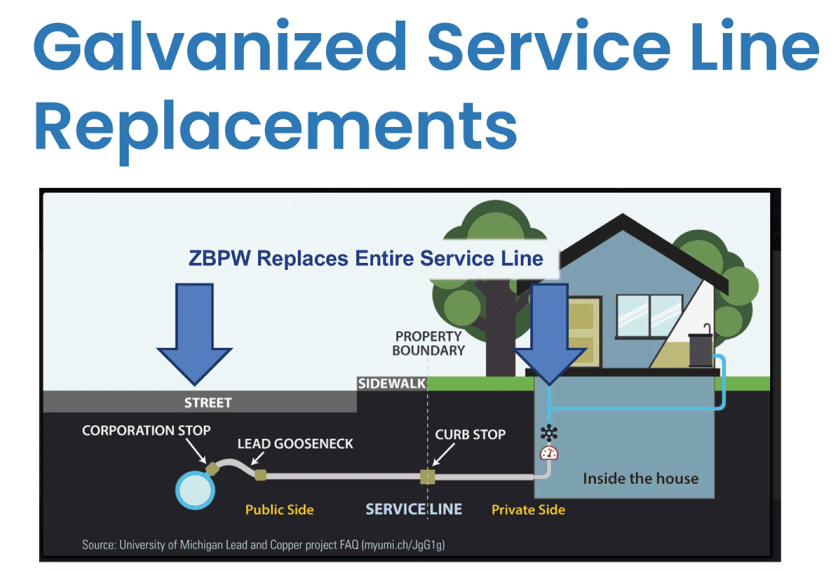Water
Galvanized Water Service Line Replacement Program
In 2018, Michigan adopted the country’s most proactive Lead and Copper Rule (LCR). This more-stringent LCR protects public health by requiring Michigan’s public water systems to take additional actions to reduce lead and copper levels in drinking water. Now, water utilities must provide an inventory of their water service connections, inform customers if their homes have a galvanized service line, and as of 2021, replace all galvanized service lines within 20 years. If we have determined that your water service line needs to be replaced, please review the important information below.
Frequently Asked Questions
Why does my water service line need to be replaced?
Prior to 1986, galvanized pipes were commonly used for drinking water supply lines in homes. These galvanized pipes were typically connected to the public water main with a short section of lead pipe (sometimes called a pigtail or gooseneck.) Because of the previous connection, galvanized service lines are now classified as lead service lines because particulate lead from the lead goosenecks could be absorbed into the soft metals of the galvanized water service line between the water main and the home. To reduce this potential risk, these galvanized pipes must be replaced by 2034.
Additional Resources: https://www.epa.gov/ground-water-and-drinking-water/lead-and-copper-rule-improvements
Is there lead in my water?
Zeeland BPW purchases its drinking water from Holland BPW which sources it from Lake Michigan. Lake Michigan is a high-quality water source that is free of major contaminants. Water supplied by Zeeland BPW does not contain lead when it leaves the treatment plant. Also, Zeeland BPW’s water distribution system is made of lead-free pipes. This means that our drinking water is not exposed to lead during the distribution process, where water from Lake Michigan pumped through the water mains that lay beneath the streets in our service area. Each home that we serve is connected to the water main by a water service line. Some older lines that connect houses to water mains may contain lead. Another potential source of lead is a is a home’s internal plumbing. Internal plumbing that could contain lead includes lead pipes, lead solder, and fixtures made of brass that contains some lead. Lead pipes and solder were officially banned in 1986, more restrictive requirements for plumbing fixtures were introduced in January 2014. All these potential sources can
What can I do to limit lead exposure until my water service line is replaced?
When will my water service line be replaced?
You can replace your galvanized water service line at your discretion, however all costs associated with this would be the responsibility of the property owner.
How long will my water service line replacement take?
Who will be replacing my water service line?
Do I have to pay for this?
How will I be impacted?
As this project moves to your neighborhood, we will contact you to schedule. On the day of your schedule replacement, we will require someone (at least 18 years of age) on site to allow our crews to enter your home. They need to gain access to the water meter in your basement. Keep in mind that the work will require shutting off your water service line for several hours.
Please be sure that on the day of your replacement, the area around the meter is free of obstacles – including cabinetry, drywall, and stored items.
The contractors will replace your water service line up to the first valve inside the building or to a point 18 inches inside the building, whichever is shorter. Any plumbing beyond this point is the responsibility of the property owner. If that plumbing material is lead or galvanized, we strongly encourage you to replace that at your cost at your first opportunity.
How will this affect my property?
The contractor will replace the existing non-copper service line from the street to your house with a copper line. The road, sidewalk and yards will be restored once all services have been installed.
What do I do after my water service line replacement?
Once we complete the water service replacement from the street to the house, we will then need to flush your water service pipes. Please open the valve to your outside faucet and make sure the outside faucet is available to use. After your pipe replacement, you must flush all of your faucets per MDEQ’s recommendation.
Please Follow These Steps:
1) Remove faucet aerators from all cold water taps in the home.
2) Beginning in the lowest level of the home, open the cold water taps completely throughout the home.
3) Let the water run for at least 30 minutes at the last tap you opened (top floor).
4) Turn off each tap starting with the taps in the highest level of the home. Be sure to run water in bathtubs and showers, as well as faucets.
Do not open hot water faucets, consume tap water, use icemakers or filtered water dispensers, until after flushing is complete.
What if I still have questions?
Contact our Water Operations Manager, Mike Levandoski, 616.772.6212.
